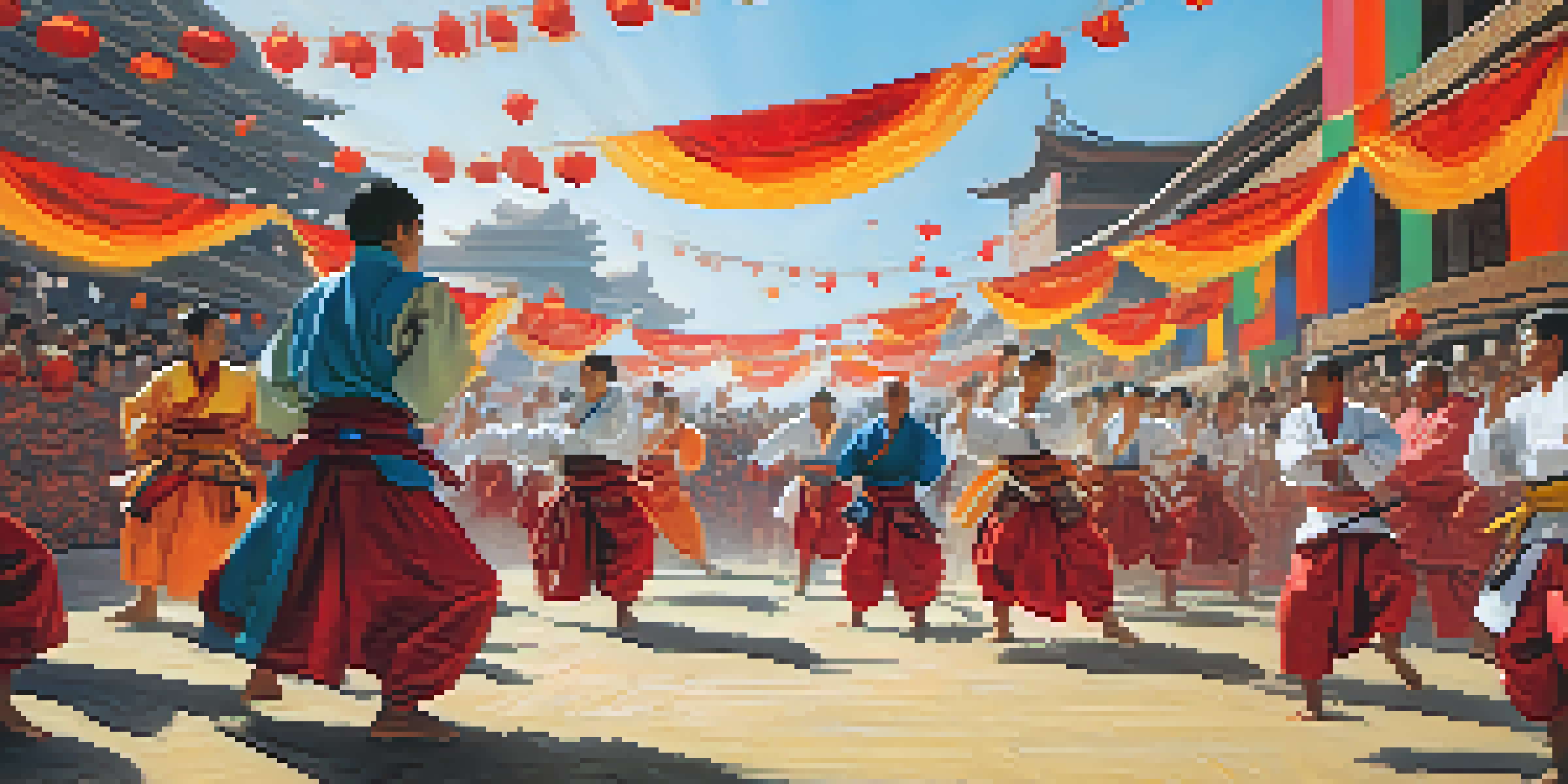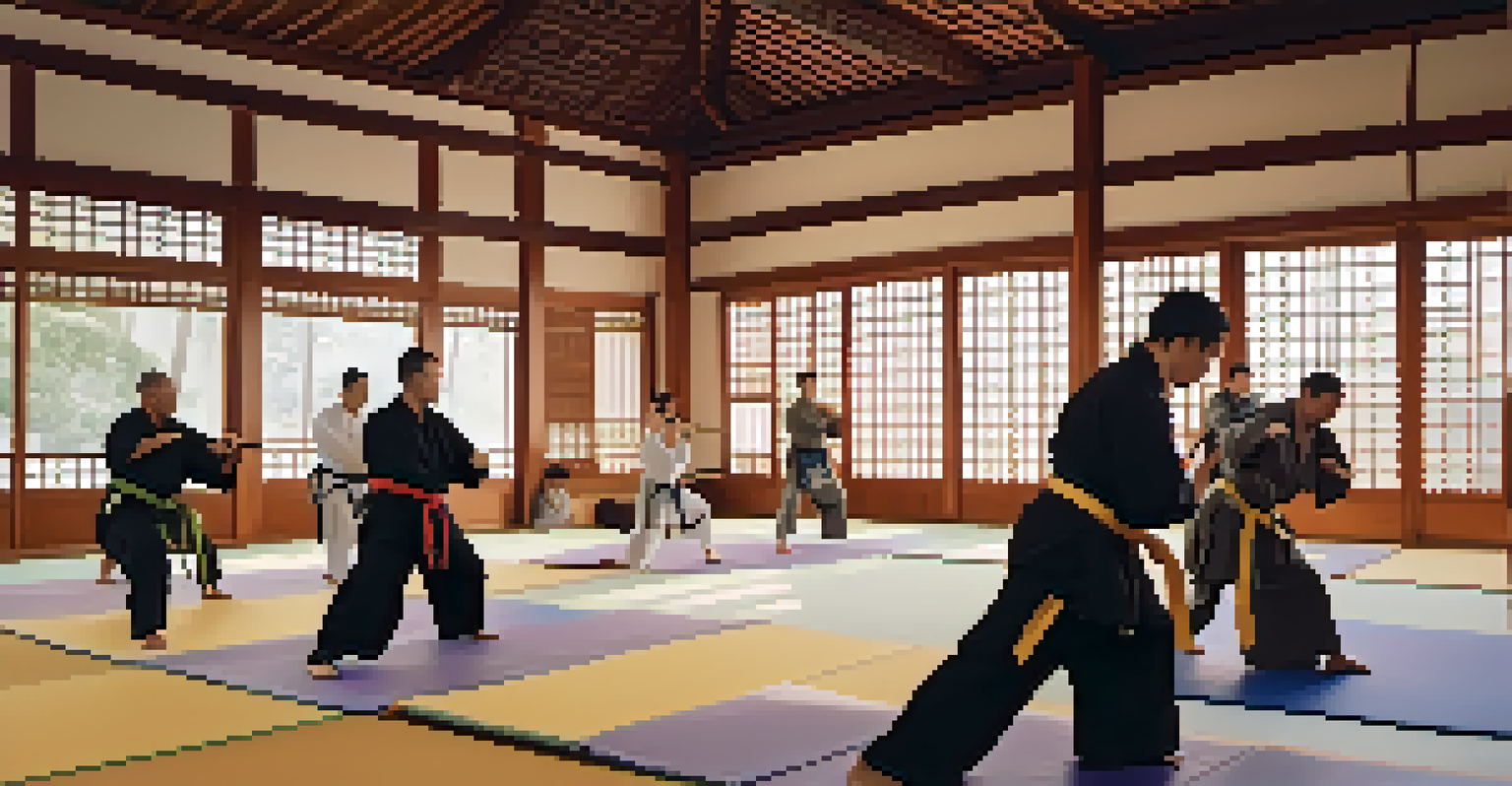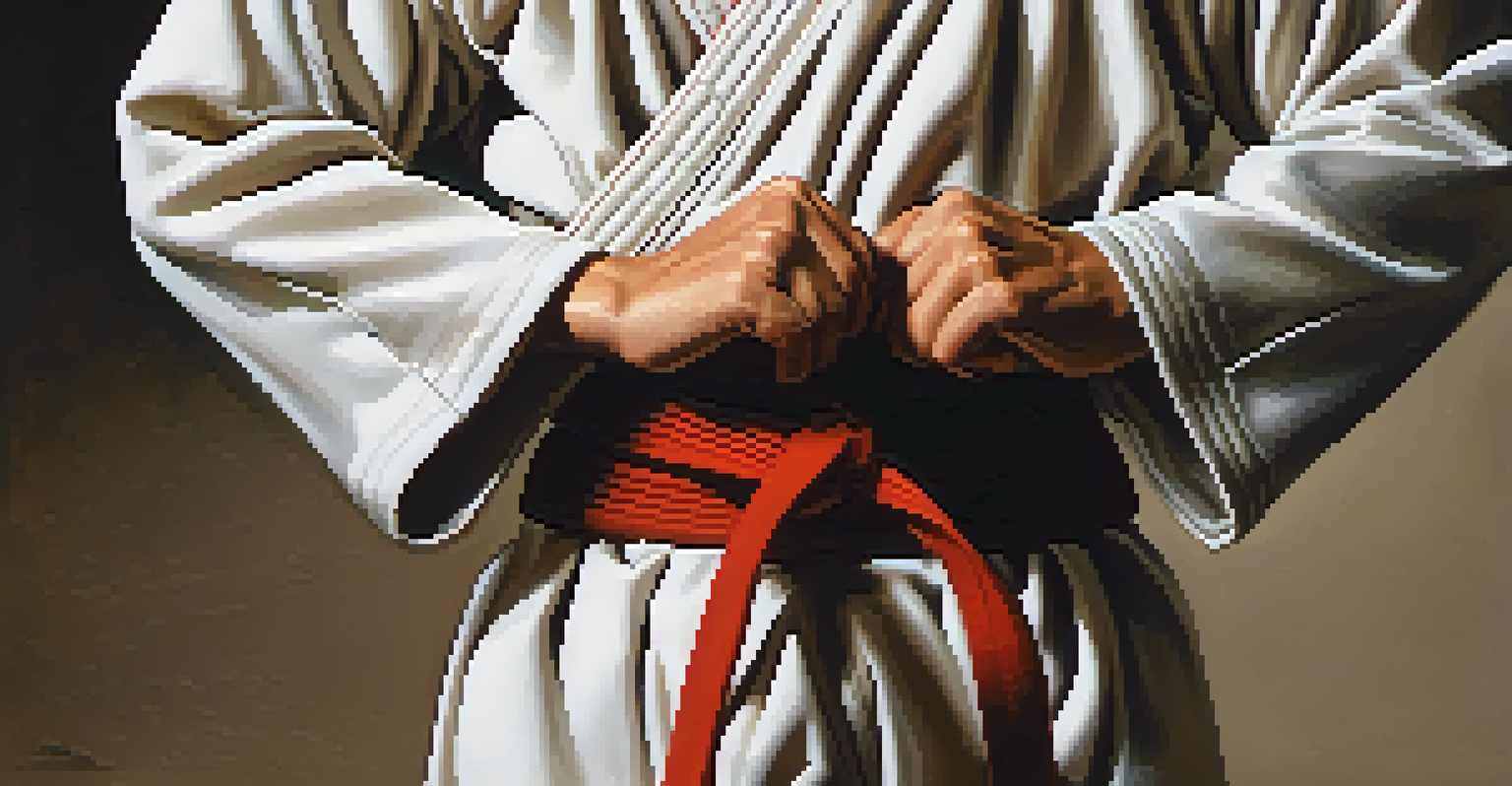Cultural Exchange Through Martial Arts: A Global Perspective

Understanding Martial Arts as a Cultural Phenomenon
Martial arts are more than just physical practices; they embody the culture and values of the societies they originate from. Each form, whether it’s Karate from Japan or Capoeira from Brazil, tells a story of historical significance and cultural expression. These disciplines reflect the philosophies, art, and traditions of their people, showing how intertwined physical movement and cultural heritage can be.
Martial arts is not about fighting; it's about building community and fostering respect among diverse cultures.
When practitioners engage in martial arts, they often immerse themselves in the accompanying customs, language, and etiquette. This cultural immersion creates a bridge between people from diverse backgrounds, fostering mutual respect and understanding. By learning a martial art, individuals become part of a larger narrative that transcends borders and fosters unity.
Furthermore, the global spread of martial arts has led to the evolution of new styles, blending various cultural elements. For example, the mix of traditional Japanese Judo techniques with modern self-defense practices highlights how cultural exchange can lead to innovation. These interactions not only enrich the martial arts community but also promote a sense of belonging among practitioners worldwide.
The Role of Martial Arts in Building Community
Martial arts schools often serve as community hubs where practitioners of all ages come together. These spaces offer not just training but also a sense of belonging and support, fostering friendships that span cultural divides. The camaraderie developed on the mats often leads to deeper discussions about cultural backgrounds, beliefs, and experiences.

Moreover, community events like tournaments and exhibitions bring together practitioners from various backgrounds, showcasing their skills and sharing their cultures. These gatherings allow people to celebrate their differences while finding common ground through shared passions. Such interactions help break down stereotypes and promote understanding, reinforcing the idea that martial arts transcend cultural boundaries.
Martial Arts as Cultural Expression
Martial arts reflect the cultural values and traditions of their origins, showcasing a blend of history and physical practice.
In many cases, martial arts also engage in community outreach, teaching self-defense and discipline to underprivileged youth. These programs not only empower individuals but also instill values of respect and perseverance, creating a ripple effect of positive change in communities. By participating in these initiatives, martial artists contribute to the cultural fabric of their neighborhoods, enhancing social cohesion.
Learning and Teaching: A Two-Way Cultural Exchange
The process of learning martial arts is inherently a two-way street. While students learn techniques and philosophies from their instructors, teachers also gain insights into their students' diverse backgrounds. This exchange of knowledge creates a rich learning environment where everyone benefits from different perspectives.
The beauty of martial arts is that it transcends cultural boundaries, connecting us all through a shared journey of growth and understanding.
For instance, a student from a different cultural background may introduce unique training methods or philosophies that influence the instructor’s approach. This blending of ideas can lead to innovative teaching styles that keep the sport dynamic and engaging. Such interactions highlight the importance of adaptability and openness in martial arts training.
Additionally, many martial arts practitioners travel to different countries to train, immersing themselves in new cultures while sharing their own. This global exchange not only enhances their skills but also fosters a deeper understanding of the world. As they bring back these experiences to their home dojos, they enrich their local communities with new techniques and cultural insights.
Martial Arts Festivals: A Celebration of Global Cultures
Martial arts festivals around the world serve as vibrant celebrations of culture, bringing together practitioners from various disciplines. These events often feature demonstrations, workshops, and competitions, creating an atmosphere of excitement and camaraderie. Attendees have the opportunity to witness a variety of martial arts forms, each representing its unique cultural heritage.
These festivals also provide a platform for cultural exchange, as practitioners share not only their techniques but also their traditions, music, and art. For example, a Taekwondo demonstration might be paired with traditional Korean music, creating a holistic cultural experience. Such interactions allow attendees to appreciate the richness of different cultures while fostering connections among martial artists worldwide.
Community Building Through Martial Arts
Martial arts schools foster a sense of belonging and camaraderie, bridging cultural divides and promoting social connections.
In addition, martial arts festivals often include seminars led by masters from various backgrounds, offering invaluable knowledge to participants. These opportunities for direct learning from experienced practitioners enrich the martial arts community and promote a sense of global unity. Ultimately, these celebrations highlight how martial arts can bridge cultural gaps and foster a sense of global belonging.
Martial Arts and Social Change: A Catalyst for Unity
Throughout history, martial arts have played a significant role in social change and unity. For example, the civil rights movement in the United States saw many African American leaders promoting martial arts as a means of empowerment and self-defense. This not only helped individuals reclaim their strength but also fostered a sense of community and solidarity.
In recent years, martial arts have been used as tools for conflict resolution and peacebuilding in various regions. Programs that teach martial arts to youth in conflict zones aim to instill discipline, respect, and teamwork, steering them away from violence. By providing a constructive outlet, these initiatives promote understanding and cooperation among diverse groups.
Additionally, martial arts can serve as a platform for raising awareness about social issues. Many practitioners use their skills to advocate for peace, equality, and cultural understanding. Through demonstrations and community engagement, they show how martial arts can contribute to a more just society, proving that the spirit of martial arts extends far beyond the dojo.
The Impact of Technology on Cultural Exchange in Martial Arts
In our digital age, technology has revolutionized how martial arts are practiced and shared globally. Online platforms allow practitioners to connect, share techniques, and learn from masters across the world without leaving their homes. This accessibility opens doors for cultural exchange, making it easier than ever to explore diverse martial arts traditions.
Social media has also played a significant role in promoting martial arts. By sharing videos of training sessions or competitions online, practitioners can showcase their cultures and styles, sparking interest and inspiring others. This not only enriches the global martial arts community but also encourages individuals to explore different cultural practices, fostering appreciation and respect.
Diversity Fuels Martial Arts Evolution
The future of martial arts relies on embracing diversity, encouraging the blend of techniques and philosophies to enhance the community.
Moreover, virtual training sessions and online tutorials have become commonplace, allowing practitioners to learn from masters who may be thousands of miles away. This technology-driven approach enhances the learning experience, enabling students to absorb various cultural elements. Ultimately, technology serves as a powerful tool for cultural exchange, bringing the world of martial arts closer together.
Embracing Diversity: The Future of Martial Arts
As martial arts continue to evolve, embracing diversity will be crucial for their future. The growing number of practitioners from various backgrounds enriches the martial arts community, encouraging the blending of techniques and philosophies. This cultural fusion not only enhances individual practices but also promotes creativity and innovation within the martial arts landscape.
Organizations and schools that prioritize inclusivity will help cultivate a more vibrant and diverse martial arts community. By welcoming practitioners of all backgrounds, they create a space where everyone can share their unique perspectives and experiences. This sense of belonging not only strengthens the community but also fosters lifelong friendships and collaborations.

Ultimately, the future of martial arts lies in their ability to adapt and embrace global influences. As practitioners continue to learn from one another, the martial arts world will thrive on the rich tapestry of cultures that contribute to its evolution. By celebrating diversity, martial arts can serve as a powerful symbol of unity, connecting people across the globe in their shared passion for self-improvement and cultural exchange.